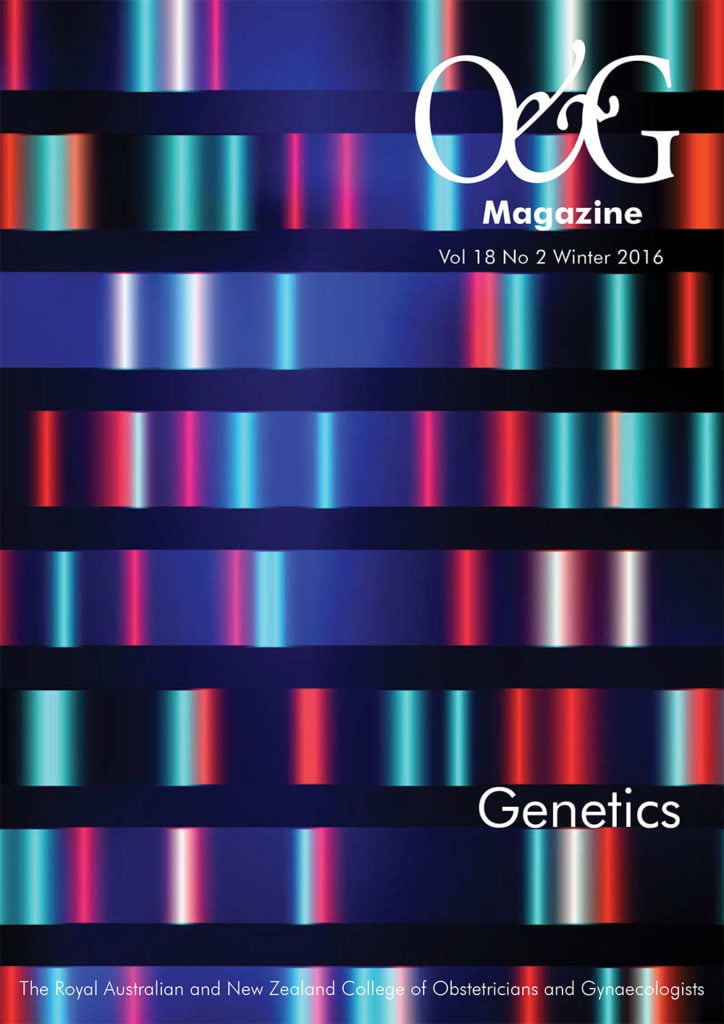Let me open this report with congratulations to Prof Stephen Robson on his election in March to President of the Tenth RANZCOG Council. Steve has made enormous contributions to the College, in almost every area of College activity – from examinations through to women’s health and publications. He will take over as President at the November Annual General Meeting. The new Board will be elected in July from the current Council and a new Council will be elected by the Fellowship in September.
Workforce
Compulsory blood-borne virus testing
Communicable Diseases Network Australia (CDNA) is a government advisory body comprising appropriate experts and representatives of the states and territories. It has had many roles, including working with the College in developing guidelines in response to the Zika virus outbreak.
Among the areas under consideration is a proposal that health professionals exposed to blood-borne viruses undertake regular (for example, annual) assessments of their blood-borne virus status. The implications of a positive result are not what they once were. Affected practitioners can expect a return to surgical practice when effective antiviral therapy has reduced the viral load to a level that is considered to have virtually no risk of transmission to patients. In addition, early diagnosis and treatment of a positive result will likely be profoundly beneficial to all affected practitioners in terms of their long-term health.
While not yet government policy, the rights to privacy of an affected individual will be paramount. There is an expectation that test results will be the sole property of the individual and any registration requirement should only be a declaration that the test has been performed.
Bullying and harassment
The College will soon circulate a survey to Fellows and trainees in relation to bullying and harassment in the workplace. While the recent focus in the media has largely been on surgeons, it is important to establish the extent of this issue within our own specialty, develop strategies for improvement and, subsequently, monitor progress. Bullying and harassment cannot be allowed to persist in the workplace. My own impression is that such episodes are very uncommon. However, it is timely for the College to review this important area.
Selection for FRANZCOG Training
At the time of writing, the New Zealand selection process is well underway and Australian applications close in mid-May. It is expected that the College will receive another record number of applications. Unfortunately, many outstanding potential future specialists will miss out on selection, largely because there are simply too many good applicants, but we must also recognise that perfection in selection is extremely difficult.
The College continues to explore methods of ensuring that the most-suited applicants emerge from the selection process as the new trainees. In striving for the most efficacious selection tools, the College is exploring the use of situational judgement tests (SJTs), which have been used extensively in the UK. Although they will not count toward the selection score this year, it is hoped that SJTs will prove to be a tool that further enhances the selection process. The College will continue to explore the possible future use of other tools and methods that can capture the desired skills and attributes. For example, it seems surprising that, in a predominantly surgical discipline, there is little in the selection score that reflects surgical aptitude.
Many Fellows and registrars are understandably frustrated by the fact that performance in the hospital before application does not appear to influence the selection process. It would seem reasonable to assume that current performance is a good predictor of future performance and that hospitals are in a valuable position to provide such information. Applicant-nominated referees almost invariably submit very good references and therefore are almost consistently unhelpful as a discriminator. Institutional references do discriminate between applicants and allow the selection process to incorporate important traits not otherwise captured, including surgical aptitude and professional attributes such as diligence and reliability. At this point, institutional references do not count in the total selection points that determine who is selected and who is not. They will continue to be evaluated for future use.
Selection for FRANZCOG training must also ensure diversity across the profession, from generalist practice to each of the five subspecialties, so that the needs of women can be met. It must also recognise workforce issues in provincial areas and indigenous communities in Australia and New Zealand.
While a specialty full of academics would be unwelcome, a clinical academic O&G workforce has become progressively more important as our practice becomes increasingly dictated by guideline-development committees. It is so much better if membership of these committees comprises clinical peers practising in the discipline in question – as exemplified by the College’s Women’s Health Committee. The evidence itself almost never dictates a guideline. It is the interpretation of all available evidence in the relevant clinical context that culminates in a clinical guideline. Only when clinicians can be said to own a guideline is there a reasonable expectation that the contents are relevant to contemporary practice.
Women’s health
Clomiphene citrate
Fellows and trainees will have been surprised to hear of an impending shortage of clomiphene citrate, which may prove to be long-lasting. My thanks to the Reproductive Endocrinology and Infertility Subspecialty Committee assisting me in formulating a response to this unfortunate situation. The College has submitted a request to the Therapeutic Goods Administration (TGA) that letrozole be licensed for ovulation induction.
Zika virus
Evidence that the Zika virus poses a genuine threat to the fetus is accumulating, although quantifying the risk continues to prove challenging, with a recent publication suggesting the fetal risk may be as high as 29 per cent in the presence of maternal infection during pregnancy. All health professionals caring for women who are, or may become, pregnant should have ready access to information regarding Zika-affected areas, management of a woman returning from a Zika-affected area and care of a pregnancy in which a Zika infection may have occurred. All this information is available on the College’s women’s health webpages, with links to the various information sheets.
PGF2 alpha
After initially receiving advice that hospital pharmacies should be able to access overseas product, following the discontinuation of locally produced prostaglandin F2 (PGF2) alpha, this is proving more difficult than expected. Hospitals may find they need to switch to 15-methyl-PGF2 alpha (carboprost; Prostinfenem). As the recommended routes and doses of PGF2 alpha and 15-methyl-PGF2 alpha are different, all obstetricians should familiarise themselves with the recommended dose and route for carboprost administration. Details are available in the modified statement on the Management of Postpartum Haemorrhage (C-Obs 43) on the College website.
Medical Benefit Schedule Revision
Recommendations from the Obstetric Clinical Committee, as outlined in previous reports, remain in progress. Although there are two general practitioner (GP) members of the Obstetric Clinical Committee, additional feedback has been sought from shared-care GPs, given suggested changes to items that may affect these practitioners.
Ultrasound has predictably proved challenging, with some expected differences of perspective between the imaging specialists and clinicians providing ultrasound at the point of care. An ultrasound performed in the rooms of a GP or specialist has obvious advantages to the patient: convenience, timeliness and, usually, a significantly lower cost. There is also an opportunity for counselling by the usual provider at the time of imaging. On the other hand, few would dispute the high-level skill of the obstetric sonologist in the diagnosis of complex fetal anomalies. To further complicate the issue, many GPs and specialists have not sought accreditation of the ultrasound performed in their rooms, with the consequence that they are unable to use the non-referred item numbers for O&G ultrasound. These GPs and specialists must currently build the costs of this service into other items in their fee structure. Ensuring quality ultrasound both at the point of care and in imaging practices are high priorities and any changes suggested must not adversely affect patient care.






Leave a Reply